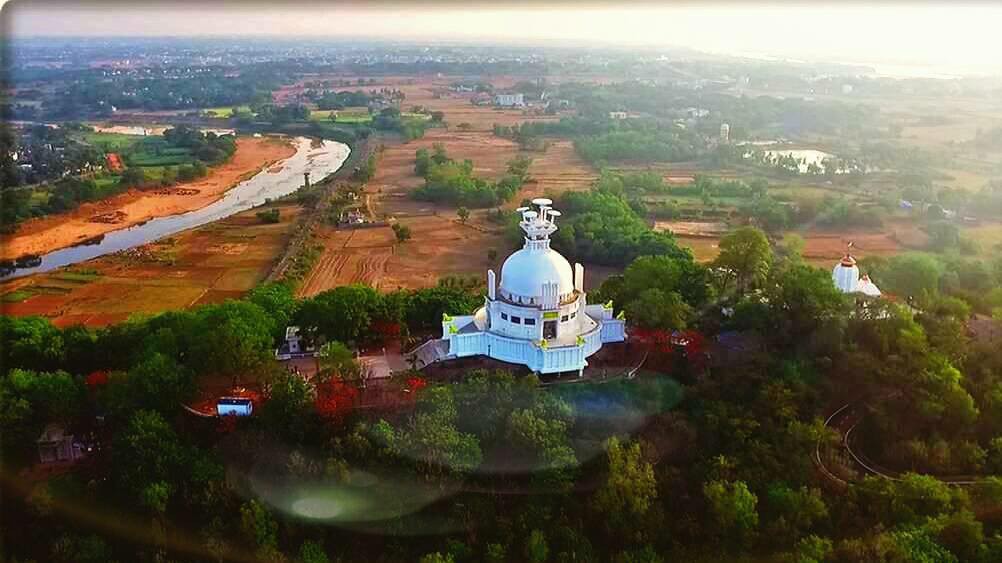
The Peace Pagoda worked by the Kalinga Nippon Budha Sangha in 1973 and known as Shanti Stupa celebrates the shift in perspective of Emperor. Ashoka had an exceptional soft spot for Dhauli, where the fight was battled. The Daya stream is said to have become red with the blood of the many perished later the fight, and empowered Ashoka to understand the greatness of loathsomeness related with war. He made sure that Dhauli turned into a significant focus of Buddhist exercises. He fabricated a few chaityas, stupas and columns there. He got houses uncovered for the hermit, guidelines recorded for authorities, clarified the primary standards of dandaniti for the general population, given extraordinary status to his new realm including the stupas at Dhauli.
There are two sanctuaries at Dhauli. One of Vairangeswar Mahadev and Dhabaleswar Mahadev. The decrees of Emperor Achok are recorded in prakrit language in bhramin script on the stone of Dhauli on the Southeast end. Discovering Dhauli Shanti Stupa
Welcome to my blog! Today, I’m excited to share my experience visiting the Dhauli Shanti Stupa in Bhubaneswar, a hidden gem that beautifully combines history, spirituality, and nature.
Located just a short drive from the bustling city of Bhubaneswar, Dhauli Shanti Stupa stands as a symbol of peace and enlightenment. This remarkable stupa is perched on a hill known as Dhauli Hills, overlooking the scenic Daya River. As you approach, the serene atmosphere wrapped in lush greenery instantly calms the soul.
Dhauli is much more than just a beautiful stupa. It holds a rich historical significance as it is believed to be the site of the Kalinga War, where Emperor Ashoka embraced Buddhism after witnessing the suffering caused by his conquests. The stupas here are said to represent the message of non-violence and tranquility that Ashoka promoted after his conversion. This aspect truly deepens the experience, as visitors reflect on the lessons of compassion and harmony.
The stupa itself is an architectural marvel. Originally built in the 2nd century BCE, it features vibrant carvings depicting scenes from the life of Buddha. The intricate designs and calming white facade create a breathtaking sight, especially at sunrise or sunset when the play of light adds an ethereal quality.
Visitors to the Dhauli Shanti Stupa can participate in meditation sessions or simply enjoy the quietude, making it an ideal spot for introspection. The surrounding gardens offer a place to sit and soak in the atmosphere, allowing for moments of reflection and peace. For those seeking spirituality, the resonance of Buddhist chants can often be heard, further enhancing the tranquil ambiance.
If you’re planning a trip to Dhauli, don’t miss the chance to explore nearby attractions like the Udayagiri and Khandagiri Caves, which are rich in history and offer stunning views of the area. Adding these to your itinerary will deepen your understanding of the region’s cultural heritage.
Best Time to Visit : The ideal time to visit the stupa is early morning or late afternoon for cooler temperatures and fewer crowds.
Dress Code : As a place of worship, it’s respectful to wear modest clothing.
Photography : Capture the beauty of the stupa, but remember to be mindful of the spiritual nature of the site.
Accessibility : The site is accessible by road, but some areas may require a small hike up the hill.
Conclusion
Dhauli Shanti Stupa is not just a monument; it is a place where history, spirituality, and beauty converge. Whether you’re a history buff, a spiritual seeker, or simply someone looking for a peaceful retreat, a visit to this stupa will leave you with lasting memories and a sense of inner calm.
For those planning to visit or looking for more information, feel free to check out [tourmyodisaha.com] for additional travel insights and tips. Happy travels!
—
If you have any questions or need further details about visits or accommodations, don’t hesitate to reach out. I’d love to help you plan your visit to this incredible site!